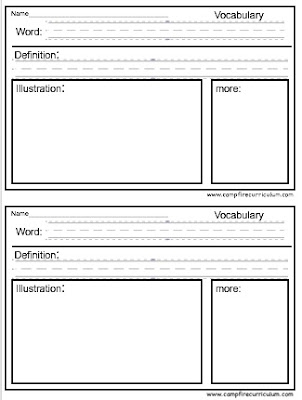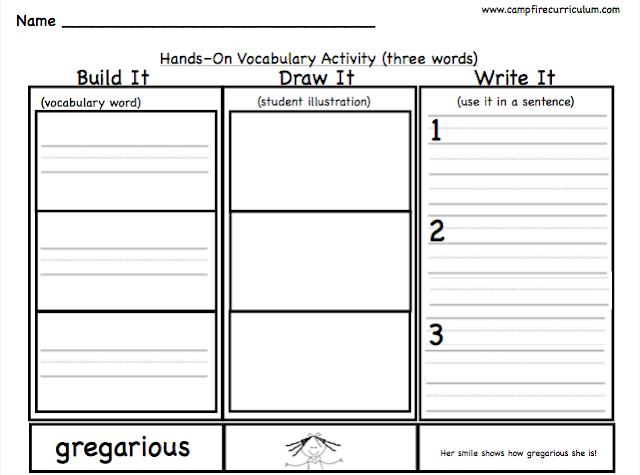Sowing The Seeds Of Vocabulary (Part Three)
A Reminder of the Research
throughout the day. American children struggle with comprehension. If we strengthen their knowledge of words throughout the day we will strengthen their response skills on tests and beyond. This post (Part Three) will make sure that you can confidently teach vocabulary in whole groups, as well as small groups.
How Will This Look In The Classroom?
Whole Group
Your school may have expectations or guidelines for vocabulary implementation. There are simple ways that you can go above and beyond, all while making vocabulary fun and easy for you and your students.
Behavior management is the cornerstone to every great classroom. Why not use it to implement academics too! At the beginning of the year have students sign (or color, as in my first grade class) a contract explaining classroom expectations. Use advanced vocabulary in the contract. I was always amazed at the students that would tell me proudly that they were working 'diligently'!
Another fun activity is "Lunch Bunch Wordies". You choose how often it happens but the object is to see how often your students use the vocabulary words that you teach them. If a student uses a vocabulary word throughout the day in conversation they can get a tally mark by their name. At the end of the week the top three vocabulary-spouting students get to have lunch with the teacher.
I also love "Awesome Analogies". As shown, you simply write an analogy on a sentence strip (or however you want to display it). When students arrive in the morning they put their answer (along with their name) on a ballot and place in a designated container. As I line my students up for lunch I would pull a ballot out. If the answer is correct, that student was able to choose a candy to bring to lunch. You can use the rest of the ballots as a formative assessment! Boom! Time saved and the students love it!

Do you have a class pledge? It's an easy way to form community bonds in class and sneak in vocabulary! In the above pledge the words respect, risk, create, celebrate, and success were used. Students said the pledge daily. You can choose to have your students participate in a classroom pledge after the morning announcements, in a morning meeting, or during calendar time. My students engaged with the pledge in a big way. Instead of putting their hands on their hearts they would hold their hands in a heart shape and look at each other while they recited it.
Send home reading (no matter what grade) that uses the vocabulary that you are teaching. Above is a good example of that. This short read is chocked full of wonderful and vivid vocabulary.
Trading cards are a fun way to engage students and really show if they have acquired the knowledge and fully understand the vocabulary. This would make a great literacy station! Students are expected to write the word, draw an illustration, and define it. You can extend this activity by asking students to find synonyms and/or antonyms (as in the card template to the left).
"Proclaim Your Vocabulary" is much like "Lunch Bunch Wordies" (above) in the sense that you are keeping track of how many students use the vocabulary throughout the school day. I like to use a plastic shoe holder, plastic buckets, and poms to keep track. When students use a word correctly you ask them to put a pom in their bucket. At the end of the month I would have students count their poms. The top student(s) would win a prize. Of course you could choose the reward that suits your class style!
Small Group
There are times when introducing the same vocabulary to all students just isn't academically appropriate. This is the time that you can differentiate your vocabulary into small group time.
Use Awesome Analogies (as above) in small group too. You can have students write down their answers and place their cards on the table face down. Guide students to share their answers and discuss why they chose certain answers. If you have students that are nervous about being wrong or sharing, give them pre-written cards and have them hand you the one that they think is the correct answer.
Choose vocabulary words for a small group. If you have three students (I know.... wishful thinking) choose three words. Write those words on sticky notes. It would be perfect if you found these words in the book being read. Have each student define their word and share it with the group. They become the master of that word and can share with others. Then students exchange words and try to build upon them throughout the next time you meet. This continues until all students have been able to master the word.
No matter what the age of the student, interactive notebooks can be an exciting way to organize and learn vocabulary. You can have 2 pockets (shown above) in each notebook. The cards that are new are placed in a "words to know" pocket. Students can use these notebooks daily in many ways. My students like to challenge each other in the morning (we have breakfast in the classroom) by asking their friends at their table what the words meant. I did not have a "words I've learned" pocket. At that point students would bring the words home. Of course you can choose to set your notebooks up in the way that works best for you! Use the templates below to set your notebooks up or use index cards.
 Two of my favorite items to use! Students love fortune tellers. The template on the left is the blank template and the one on the right shows you where to place the vocabulary word and definitions. Older students could create their own! This is really fun to use in small group. Use words included in the book they are reading in small group to choose the words!
Two of my favorite items to use! Students love fortune tellers. The template on the left is the blank template and the one on the right shows you where to place the vocabulary word and definitions. Older students could create their own! This is really fun to use in small group. Use words included in the book they are reading in small group to choose the words!Simply use a brown lunch bag to create what I call "Bag It". Students can place their differentiated vocabulary/definition cards in the pocket that is created by folding the bag. The other side of the folded bag creates a fun flap that can be lifted to show a definition underneath. One package of 100 bags can be purchased at the dollar store. This activity is fun and won't break the bank!
Hand Over The Knowledge With Meaning

Don't forget to use this thinking: I Do, We Do, You Do in every lesson plan.
I DO- Sometimes we think that students should know what to do but our modeling is very important.
Take a few moments at the beginning of your vocabulary lessons to fully model what you expect. Introduce the new activity, share what you know about the vocabulary word by telling a story, allow students to talk to each other and make connections, and illustrate. For young students, illustrations can be very powerful in making vocabulary connections.
WE DO- After you have completely modeled, move into working with your students. Create anchor charts as a class, work on vocabulary notebooks, or share/trade vocabulary cards.
YOU DO- This is when students can work independently. Allow students to create on their own. Don't forget to check their work to make sure that they have the correct definitions/illustrations prior to gluing vocabulary sheets into a notebook or sending them home.
Remember This While Planning
Allow students of all ages to build, draw, and write to gain a full understanding of every word!
Build It: Allow students to manipulate vocabulary words. Have students match, sort, and group words in alphabetical order. Have students find the correct antonyms and synonyms. Remember that to certain students building may be as simple as a discussion where they are developing schema. Don't forget the importance of classroom conversation.
Draw It: Illustrating helps students connect to words. Students can label or write a sentence after illustrating to prove their knowledge.
Write It: Here is where they prove their knowledge to you. Depending on the grade level, you can have students cut and match words, label, write a definition, write a sentence, or write a story.
Technology!
Check out these awesome ideas using technology:
Flip Book on PowerPoint
Doodle Splash by Read Think Write
Flash Card Maker by Scholastic
Trading Card Creator by Read Think Write
Kidspiration Template
Popplet Lite App on iPad
Flashcardlet App on iPad



























No comments